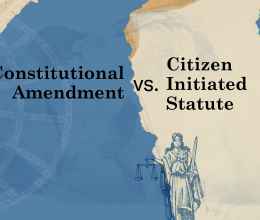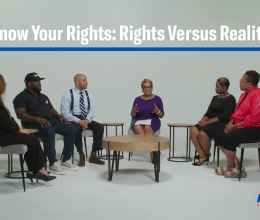When you think of the term "bail" do you tend to visualize bond agents, bounty hunters, and flashing neon signs with names like ABC Bonds, A-1 Bonds, EZ Bonds? That’s what we thought.
The reason you likely think this way is because that's what you've been taught to think by what you've seen or heard about the American bail process. And for the most part, you are justified in your assumption that bail, in a real sense of the word, equals the payment of money. And nowadays, bail can be equated with terms like profiteering and corruption, but we’ll get into that a bit later.
More often than not, Judges around the country and in Ohio require the accused to pay the court before they can be released. We see this all the time in television shows and movies, to the point where we are indoctrinated to believe that money bail is a part-and-parcel of the American criminal legal system. You might be surprised to know that it hasn't always been this way.
Early Period
The initial concept of bail (the practice of releasing a person from jail prior to their court date) is centuries old. In the fifth century of the current era, when Germanic tribes migrated to the island of Britain, they brought with them the practice of settling disputes with brute force. This often times lead to private wars between the victim and the accused's families resulting in physical harm and loss to both groups. As time went on, people came to realize that their system of “brute- force –justice” was too costly and as a result a new system of conflict resolution emerged.
The new system focused on goods or monetary compensation for the wrongs, rather than physical harm. Under the new system, when a person or group of people were accused of committing a crime, the accused person's family would agree to repay the victim's family in goods or money over a period of time. In exchange, the victim and family would promise not to retaliate against the accused.
Thus, the accused's family would act as a A b, which is defined as the person(s) liable for paying another’s debt or obligation. The surety, generally a representative of the family, was also known as the “pledge" or the "bail." This person (a personal lender) made sure that the accused paid the debt by agreeing to stand in the place of the accused if the debt wasn't paid by him.
Many historians agree that this system of justice was the precursor to early and modern American bail practices. One key difference, however, was that, back in the day, sureties were not allowed to be repaid or otherwise profit from the surety arrangement. If only that were the case today…
Early American Period
It wasn’t until the early 20th century that America shifted gears and began implementing commercial securities and secured money bonds in exchange for the personal sureties of the past. The new commercial surety system thrived on profit for the lender, because the accused would have to compensate the bond agent for essentially “co-signing” his or her release, a forbidden practice in the past. As stated in the National Institute of Corrections’ report, Fundamentals of Bail, “[i]n both England and America, courts repeatedly articulated [] the following rationale when declaring surety” compensation unlawful: “once a surety was paid or given a promise to be paid the amount that could potentially be forfeited, that surety lost all interest and motivation to make sure that the condition of release was performed."
It’s now thought that the expanding American frontier diminished the close personal relationships necessary for the personal surety system to succeed. With fewer persons available to pledge themselves as sureties for their family and friends, more defendants were being detained.
This cultural shift led America towards a system of commercial sureties with bail bond agents and self-pay. State courts and legislatures across the country started enacting laws allowing compensation of sureties, which made bail “big business.”
Bail bond agents were charged with ensuring that the defendant appeared at his scheduled court date and were allowed to demand repayment if the defendant defaulted on his or her promise to appear. Bond agents also began charging upfront and non-refundable fees for their services. Courts and legislatures also began allowing defendants to self-pay for their release in greater frequency. Self-pay, of course, only applied to those who could afford it, further bolstering a two-tier system where wealthier people accused of a crime go free while poorer defendants remain incarcerated.
America's switch to commercial sureties was in no way necessary. By way of contrast, England also experienced a decline in personal sureties around the same time as America, but instead of embracing a commercial surety system, England changed its laws to give judges discretion not to require sureties where the circumstances of a particular case showed there were none to be had.
Modern American Period
For decades, the American bail system carried on with its use of commercial sureties despite almost immediate criticism from academics and legal professionals for essentially profiting off the poor. From 1920 to 1960, academics and researchers forged a path to reform the bail system to deprioritize commercial sureties in favor of alternatives like recognizance release (nonfinancial release on nothing more than person’s promise to reappear) and nonfinancial conditional release (where no money is required upfront but the judge may require the defendant to meet certain conditions such as stay-away-orders or weekly contact with pretrial services).
The purpose of the reforms was to ensure that defendants were released and weren't languishing in jail because they couldn't afford bail. This revision is considered the first wave of bail reform in America. It focused on release, rather than detention.
The Federal Bail Reform Act of 1966, and many state statutes modeled after it, encouraged the release of defendants by the least restrictive means (specifically nonfinancial release) to ensure appearance in court.
The second wave of bail reform came from 1960 to 1980 and focused on detention rather than release. In 1984, Congress passed the federal enabling preventative detention based on public safety concerns in addition to concerns that the person would fail to appear at trial. States began passing and enacting similar measures that allowed for pretrial detention based on safety and appearance risk. The Bail Reform Act of 1984 was upheld on appeal to the Supreme Court in United States v. Salerno because of carefully structured procedural requirements within the act that strictly defined when a person could be deemed too risky to be released. Specifically, the act required a hearing on a motion to detain, and gave the defendant a right to counsel at the hearing, a right to call and cross-examine witnesses, and a right to appeal the decision of the court if it ruled in favor of detainment.
Although federal and many state legislatures crafted constitutional procedural rules that would ensure that only the most risky defendants were detained—including safeguards that would guarantee that courts follow the procedures for denying a person bail—most state courts ignored them. Instead, what typically happens in Ohio and other states is that a judge will set a high money bond with the purpose of detaining an individual until the conclusion of the trial. In Ohio, most money bonds are set without any appreciation for the defendant's ability to pay and are based in large part on the level of offense charged. Setting a bond that is too high, with the purpose of detaining a defendant, is unlawful. It violates the defendant's due process rights by circumventing the hearing process, the right to counsel, the right to call and confront witnesses, and the right to appeal the court's decision. Essentially, the individual is being unconstitutionally held.
Because of the unconstitutional setting of money bonds, and the inherent economic and racial inequities that come with setting financial conditions to pretrial release, America has embarked on a third-generation of bail reform. Across the country several states have reformed their constitutions and statutes. It’s crucial that courts prioritize release by turning away from secured money bonds and instead use the least restrictive means necessary to ensure public safety and appearance. In the words of Timothy R. Schnacke, a leading researcher and author on pretrial practice in Fundamentals of Bail, "[p]retrial justice in America requires a complete cultural change from one in which we primarily associate bail with money to one in which we do not."
***The information contained in this blog was primarily taken from Timothy R. Schnacke’s 2014 publication entitled Fundamentals of Bail: A Resource Guide for Pretrial Practitioners and a Framework for American Pretrial Reform, which was funded by the National Institute of Corrections and the U.S. Department of Justice.








